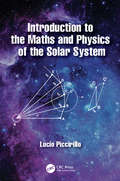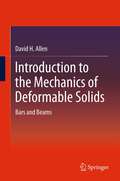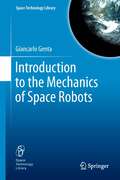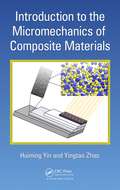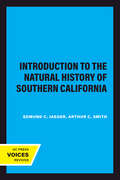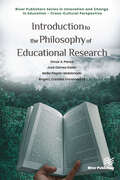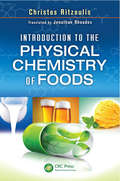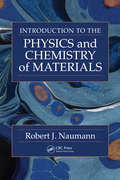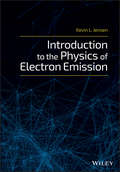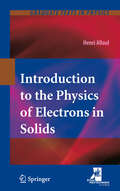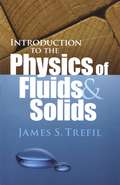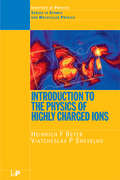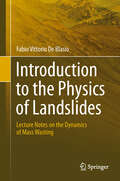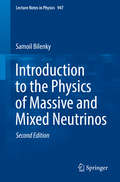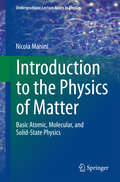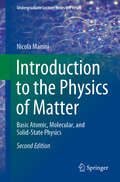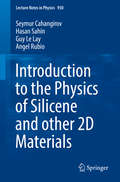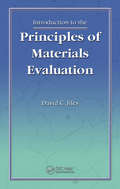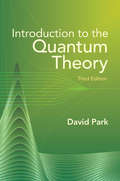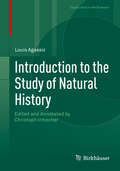- Table View
- List View
Introduction to the Maths and Physics of the Solar System
by Lucio PiccirilloThis book provides readers with an understanding of the basic physics and mathematics that governs our solar system. It explores the mechanics of our Sun and planets; their orbits, tides, eclipses and many other fascinating phenomena. This book is a valuable resource for undergraduate students studying astronomy and should be used in conjunction with other introductory astronomy textbooks in the field to provide additional learning opportunities. Features: Written in an engaging and approachable manner, with fully explained mathematics and physics concepts Suitable as a companion to all introductory astronomy textbooks Accessible to a general audience
Introduction to the Mechanics of Deformable Solids
by David H. AllenIntroduction to the Mechanics of Deformable Solids: Bars and Beams introduces the theory of beams and bars, including axial, torsion, and bending loading and analysis of bars that are subjected to combined loadings, including resulting complex stress states using Mohr's circle. The book provides failure analysis based on maximum stress criteria and introduces design using models developed in the text. Throughout the book, the author emphasizes fundamentals, including consistent mathematical notation. The author also presents the fundamentals of the mechanics of solids in such a way that the beginning student is able to progress directly to a follow-up course that utilizes two- and three-dimensional finite element codes imbedded within modern software packages for structural design purposes. As such, excessive details included in the previous generation of textbooks on the subject are obviated due to their obsolescence with the availability of today's finite element software packages.
Introduction to the Mechanics of Space Robots
by Giancarlo GentaBased on lecture notes on a space robotics course, this book offers a pedagogical introduction to the mechanics of space robots. After presenting an overview of the environments and conditions space robots have to work in, the author discusses a variety of manipulatory devices robots may use to perform their tasks. This is followed by a discussion of robot mobility in these environments and the various technical approaches. The last two chapters are dedicated to actuators, sensors and power systems used in space robots. This book fills a gap in the space technology literature and will be useful for students and for those who have an interest in the broad and highly interdisciplinary field of space robotics, and in particular in its mechanical aspects.
Introduction to the Micromechanics of Composite Materials
by Huiming Yin Yingtao ZhaoPresents Concepts That Can Be Used in Design, Processing, Testing, and Control of Composite MaterialsIntroduction to the Micromechanics of Composite Materials weaves together the basic concepts, mathematical fundamentals, and formulations of micromechanics into a systemic approach for understanding and modeling the effective material behavior of co
Introduction to the Natural History of Southern California (California Natural History Guides #13)
by Edmund C. Jaeger Arthur C. SmithThis title is part of UC Press's Voices Revived program, which commemorates University of California Press’s mission to seek out and cultivate the brightest minds and give them voice, reach, and impact. Drawing on a backlist dating to 1893, Voices Revived makes high-quality, peer-reviewed scholarship accessible once again using print-on-demand technology. This title was originally published in 1966.This title is part of UC Press's Voices Revived program, which commemorates University of California Press’s mission to seek out and cultivate the brightest minds and give them voice, reach, and impact. Drawing on a backlist dating to 1893, Voices Revived</DIV
Introduction to the Philosophy of Educational Research
by Omar A. Ponce Jose Gomez Galan Nellie Pagán-Maldonado Angel L. EncarnaciónThis book provides an accessible introduction to the philosophy of educational research. A historical-philosophical journey presents the development of research methods from their origins to the present day. In addition, the book reflects on how research methods have influenced scientific effectiveness. Throughout, the book covers the principal things that need to be known today about the theory and practice of educational research, its epistemological bases, and its development as a discipline within scientific knowledge. The historical events that defined both the methodological evolution and the current situation of contemporary educational research are described to enable its understanding.This book provides an accessible introduction to the philosophy of educational research. A historical-philosophical journey presents the development of research methods from their origins to the present day.. It can also be used as didactic material for classroom discussions on educational research, educational philosophy, and current controversies in education. Its usefulness reaches the social sciences, humanities, and experimental sciences in all areas related to teaching and training. The basis of educational research is exposed, both in its concepts or philosophical visions and methodologies, which ultimately define what education means today.
Introduction to the Physical Chemistry of Foods
by Christos RitzoulisIntroduction to the Physical Chemistry of Foods provides an easy-to-understand text that encompasses the basic principles of physical chemistry and their relationship to foods and their processing. Based on the author's years of teaching and research experience in the physical chemistry of food, this book offers the necessary depth of information a
Introduction to the Physics and Chemistry of Materials
by Robert J. NaumannDiscusses the Structure and Properties of Materials and How These Materials Are Used in Diverse ApplicationsBuilding on undergraduate students' backgrounds in mathematics, science, and engineering, Introduction to the Physics and Chemistry of Materials provides the foundation needed for more advanced work in materials science. Ideal for a two-semes
Introduction to the Physics of Electron Emission
by Kevin L. JensenA practical, in-depth description of the physics behind electron emission physics and its usage in science and technology Electron emission is both a fundamental phenomenon and an enabling component that lies at the very heart of modern science and technology. Written by a recognized authority in the field, with expertise in both electron emission physics and electron beam physics, An Introduction to Electron Emission provides an in-depth look at the physics behind thermal, field, photo, and secondary electron emission mechanisms, how that physics affects the beams that result through space charge and emittance growth, and explores the physics behind their utilization in an array of applications. The book addresses mathematical and numerical methods underlying electron emission, describing where the equations originated, how they are related, and how they may be correctly used to model actual sources for devices using electron beams. Writing for the beam physics and solid state communities, the author explores applications of electron emission methodology to solid state, statistical, and quantum mechanical ideas and concepts related to simulations of electron beams to condensed matter, solid state and fabrication communities. Provides an extensive description of the physics behind four electron emission mechanisms—field, photo, and secondary, and how that physics relates to factors such as space charge and emittance that affect electron beams. Introduces readers to mathematical and numerical methods, their origins, and how they may be correctly used to model actual sources for devices using electron beams Demonstrates applications of electron methodology as well as quantum mechanical concepts related to simulations of electron beams to solid state design and manufacture Designed to function as both a graduate-level text and a reference for research professionals Introduction to the Physics of Electron Emission is a valuable learning tool for postgraduates studying quantum mechanics, statistical mechanics, solid state physics, electron transport, and beam physics. It is also an indispensable resource for academic researchers and professionals who use electron sources, model electron emission, develop cathode technologies, or utilize electron beams.
Introduction to the Physics of Electrons in Solids
by Henri Alloul Stephen LyleThis textbook sets out to enable readers to understand fundamental aspects underlying quantum macroscopic phenomena in solids, primarily through the modern experimental techniques and results. The classic independent-electrons approach for describing the electronic structure in terms of energy bands helps explain the occurrence of metals, insulators and semiconductors. It is underlined that superconductivity and magnetism can only be understood by taking into account the interactions between electrons. The text recounts the experimental observations that have revealed the main properties of the superconductors and were essential to track its physical origin. While fundamental concepts are underlined, those which are required to describe the high technology applications, present or future, are emphasized as well. Problem sets involve experimental approaches and tools which support a practical understanding of the materials and their behaviour.
Introduction to the Physics of Fluids and Solids
by James S. TrefilWritten by a well-known science author, this introductory text explores the physics of solids and the field of hydrodynamics. It focuses on modern applications, rather than mathematical formalism, with particular emphasis on geophysics, astrophysics, and medical physics. Suitable for a one-semester course, it is geared toward advanced undergraduate physics students and graduate science students. It also serves as a helpful reference for professional astronomers, chemists, and engineers. Geophysical topics include the circulation of the atmosphere, vibrations of the earth, and underground nuclear tests. Subjects related to medicine include the urinary system and blood flow, and miscellaneous topics of interest include tides, Saturn's rings, the rotation of the galaxy, and nuclear fission. Each chapter offers many vivid examples of current interest, along with 10 to 15 problems that amplify the text and apply its teachings to new situations.
Introduction to the Physics of Gyrotrons
by Gregory S. NusinovichAs unique sources of coherent high-power, microwave, and millimeter-wave radiation, gyrotrons are an essential part of the hunt for controlled fusion. Presently, gyrotrons are actively used for electron cyclotron resonance plasma heating and current drive in various controlled fusion reactors. These sources have been under development in many countries for more than forty years. In spite of their widespread use, however, there is as yet no single book to introduce non-specialists to this vital field.Now Gregory S. Nusinovich, an early pioneer of the gyrotron and widely regarded today as the world's leading authority on the subject, explains the fundamental physical principles upon which gyrotrons and related devices operate. Nusinovich first sets forth some "rules of thumb" that allow readers to understand gyrotron operation in simple terms. He then explores the fundamentals of the general theory of gyrotrons and offers an overview of the various types of gyro-devices, including gyromonotrons, gyroklystrons, gyro-traveling-wave tubes, and gyrotwystrons. He explains not only the theory, linear and nonlinear, but also the practical challenges that users of such devices face. This book will be of interest to undergraduate and graduate students as well as to those who develop gyrotrons or who use them in various applications. It should also appeal to plasma physicists interested in charged-particle dynamics, as well as to applied physicists needing to know more about micro- and millimeter-wave technologies.
Introduction to the Physics of Highly Charged Ions (Series in Atomic Molecular Physics)
by Heinrich F. Beyer Viateheslav P. ShevelkoEmphasizing a physical understanding with many illustrations, Introduction to the Physics of Highly Charged Ions covers the major areas of x-ray radiation and elementary atomic processes occurring with highly charged ions in hot laboratory and astrophysical plasmas. Topics include light and ion sources, spectroscopy, atomic structure, magnetic and
Introduction to the Physics of Landslides
by Fabio Vittorio BlasioLandslides represent one of the most destructive natural catastrophes. They can reach extremely long distances and velocities, and are capable of wiping out human communities and settlements. Yet landslides have a creative facet as they contribute to the modification of the landscape. They are the consequence of the gravity pull jointly with the tectonic disturbance of our living planet. Landslides are most often studied within a geotechnical and geomorphological perspective. Engineering calculations are traditionally applied to the stability of terrains. In this book, landslides are viewed as a physical phenomenon. A physical understanding of landslides is a basis for modeling and mitigation and for understanding their flow behavior and dynamics. We still know relatively little about many aspects of landslide physics. It is only recently that the field of landslide dynamics is approaching a more mature stage. This is testified by the release of modelling tools for the simulation of landslides and debris flows. In this book the emphasis is placed on the problems at the frontier of landslide research. Each chapter is self-consistent, with questions and arguments introduced from the beginning.
Introduction to the Physics of Massive and Mixed Neutrinos
by Samoil BilenkyThe discovery of neutrino oscillations opened a new era in neutrino physics: an era of investigation of neutrino masses, mixing, magnetic moments and other neutrino properties. On the other hand small neutrino masses cannot be explained by the standard Higgs mechanism of mass generation. Thus, small neutrino masses are the first signature in particle physics of a new beyond the Standard Model physics. One of the most important challenges ahead is the problem of the very nature of neutrinos with definite masses: are they Dirac neutrinos possessing a conserved lepton number which distinguish neutrinos and antineutrinos or Majorana neutrinos with identical neutrinos and antineutrinos? Many experiments of the next generation and new neutrino facilities are now under preparation and investigation. This book is intended as an gentle but detailed introduction to the physics of massive and mixed neutrinos that will prepare graduate students and young researchers entering the field for the exciting years of neutrino physics to come. It is based on numerous lectures given by the author, one of the pioneers of modern neutrino physics (recipient of the Bruno Pontecorvo Prize 2002), at different institutions and schools.
Introduction to the Physics of Massive and Mixed Neutrinos (Lecture Notes in Physics #817)
by Samoil BilenkySmall neutrino masses are the first signs of new physics beyond the Standard Model of particle physics. Since the first edition of this textbook appeared in 2010, the Nobel Prize has been awarded "for the discovery of neutrino oscillations, which shows that neutrinos have mass". The measurement of the small neutrino mixing angle $\theta_{13}$ in 2012, launched the precision stage of the investigation of neutrino oscillations. This measurement now allows such fundamental problems as the three-neutrino mass spectrum - is it normal or inverted? – and the $CP$ violation in the lepton sector to be tackled. In order to understand the origin of small neutrino masses, it remains crucial to reveal the nature of neutrinos with definite masses: are they Dirac neutrinos possessing a conserved lepton number, which distinguishes neutrinos and antineutrinos, or are they Majorana neutrinos with identical neutrinos and antineutrinos? Experiments searching for the neutrinoless double beta decay are presently under way to answer this fundamental question. The second edition of this book comprehensively discusses all these important recent developments. Based on numerous lectures given by the author, a pioneer of modern neutrino physics (recipient of the Bruno Pontecorvo Prize 2002), at different institutions and schools, it offers a gentle yet detailed introduction to the physics of massive and mixed neutrinos that prepares graduate students and young researchers entering the field for the exciting years ahead in neutrino physics.
Introduction to the Physics of Matter
by Nicola ManiniThis book offers an up-to-date, compact presentation of basic topics in the physics of matter, from atoms to molecules to solids, including elements of statistical mechanics. The adiabatic separation of the motion of electrons and nuclei in matter and its spectroscopic implications are outlined for molecules and recalled regularly in the study of the dynamics of gases and solids. Numerous experiments are described and more than 160 figures give a clear visual impression of the main concepts. Sufficient detail of mathematical derivations is provided to enable students to follow easily. The focus is on present-day understanding and especially on phenomena fitting various independent-particle models. The historical development of this understanding, and phenomena such as magnetism and superconductivity, where interparticle interactions and nonadiabatic effects play a crucial role, are mostly omitted. A final outlook section stimulates the curiosity of the reader to pursue the study of such advanced topics in graduate courses.
Introduction to the Physics of Matter: Basic Atomic, Molecular, and Solid-State Physics (Undergraduate Lecture Notes in Physics)
by Nicola ManiniThis is the second edition of a well-received book. It provides an up-to-date, concise review of essential topics in the physics of matter, from atoms and molecules to solids, including elements of statistical mechanics. It features over 160 completely revised and enhanced figures illustrating the main physical concepts and the fundamental experimental facts, and discusses selected experiments, mainly in spectroscopy and thermodynamics, within the general framework of the adiabatic separation of the motions of electrons and nuclei. The book focuses on what can be described in terms of independent-particle models, providing the mathematical derivations in sufficient detail for readers to grasp the relevant physics involved. The final section offers a glimpse of more advanced topics, including magnetism and superconductivity, sparking readers’ curiosity to further explore the latest developments in the physics of matter.
Introduction to the Physics of Silicene and other 2D Materials
by Angel Rubio Seymur Cahangirov Hasan Sahin Guy Le LayThis concise book offers an essential introduction and reference guide for the many newcomers to the field of physics of elemental 2D materials. Silicene and related materials are currently among the most actively studied materials, especially following the first experimental synthesis on substrates in 2012. Accordingly, this primer introduces and reviews the most crucial developments regarding silicene from both theoretical and experimental perspectives. At the same time the reader is guided through the extensive body of relevant foundational literature. The text starts with a brief history of silicene, followed by a comparison of the bonding nature in silicon versus carbon atoms. Here, a simple but robust framework is established to help the reader follow the concepts presented throughout the book. The book then presents the atomic and electronic structure of free-standing silicene, followed by an account of the experimental realization of silicene on substrates. This topic is subsequently developed further to discuss various reconstructions that silicene acquires due to interactions with the substrate and how such effects are mirrored in the electronic properties. Next the book examines the dumbbell structure that is the key to understanding the growth mechanism and atomic structure of multilayer silicene. Last but not least, it addresses similar effects in other elemental 2D materials from group IV (germanene, stanane), group V (phosphorene) and group III (borophene), as well as transition metal dichalcogenides and other compositions, so as to provide a general comparative overview of their electronic properties.
Introduction to the Physics of Waves
by Tim FreegardeBalancing concise mathematical analysis with the real-world examples and practical applications that inspire students, this textbook provides a clear and approachable introduction to the physics of waves. The author shows through a broad approach how wave phenomena can be observed in a variety of physical situations and explains how their characteristics are linked to specific physical rules, from Maxwell's equations to Newton's laws of motion. Building on the logic and simple physics behind each phenomenon, the book draws on everyday, practical applications of wave phenomena, ranging from electromagnetism to oceanography, helping to engage students and connect core theory with practice. Mathematical derivations are kept brief and textual commentary provides a non-mathematical perspective. Optional sections provide more examples along with higher-level analyses and discussion. This textbook introduces the physics of wave phenomena in a refreshingly approachable way, making it ideal for first- and second-year undergraduate students in the physical sciences.
Introduction to the Principles of Materials Evaluation
by David C. JilesChoosing the proper material testing technique is important not just for economic reasons; in many circumstances, it can save lives. Building on the common links among all types of material evaluation methods, Introduction to the Principles of Materials Evaluation presents a thorough examination of all types of destructive and nondestructive
Introduction to the Quantum Theory: Third Edition
by David ParkMore than a chance to gain new insights into physics, this book offers students the opportunity to look at what they already know about the subject in an improved way. Geared toward upper-level undergraduates and graduate students, this self-contained first course in quantum mechanics consists of two parts: the first covers basic theory, and the second part presents selected applications. Numerous problems of varying difficulty examine not only the steps of the proofs but also related ideas.Starting with an introduction that ventures beyond classical physics, the first part examines the physical content of the wave function; general principles; physics in one dimension; hermitian operators, symmetry, and angular momentum; and systems in two and three dimensions. Additional topics include approximate methods of calculation; the theory of scattering; spin and isospin; questions of physical meaning; electromagnetic radiation; systems containing identical particles; and classical dynamics and Feynman's construction. Focusing on applications, the second part explores the theory of alpha decay; electrons in a periodic lattice; the hydrogen spectrum; the helium atom; interatomic forces; the neutron-proton interaction; and the quark model of baryons.
Introduction to the Senses
by Terry R.J. BossomaierAn understanding of the senses - vision, hearing, touch, chemical and other non-human senses - is important not only for many fields of biology but also in applied areas such as human computer interaction, robotics and computer games. Using information theory as a unifying framework, this is a wide-ranging survey of sensory systems, covering all known senses. The book draws on three unifying principles to examine senses: the Nyquist sampling theorem; Shannon's information theory; and the creation of different streams of information to subserve different tasks. This framework is used to discuss the fascinating role of sensory adaptation in the context of environment and lifestyle. Providing a fundamental grounding in sensory perception, the book then demonstrates how this knowledge can be applied to the design of human-computer interfaces and virtual environments. It is an ideal resource for both graduate and undergraduate students of biology, engineering (robotics) and computer science.
Introduction to the Statistical Physics of Integrable Many-body Systems
by Z. Bajnok L. SamajIncluding topics not traditionally covered in literature, such as (1+1)-dimensional QFT and classical 2D Coulomb gases, this book considers a wide range of models and demonstrates a number of situations to which they can be applied. Beginning with a treatise of nonrelativistic 1D continuum Fermi and Bose quantum gases of identical spinless particles, the book describes the quantum inverse scattering method and the analysis of the related Yang-Baxter equation and integrable quantum Heisenberg models. It also discusses systems within condensed matter physics, the complete solution of the sine-Gordon model and modern trends in the thermodynamic Bethe ansatz. Each chapter concludes with problems and solutions to help consolidate the reader's understanding of the theory and its applications. Basic knowledge of quantum mechanics and equilibrium statistical physics is assumed, making this book suitable for graduate students and researchers in statistical physics, quantum mechanics and mathematical and theoretical physics.
Introduction to the Study of Natural History
by Christoph Irmscher Louis AgassizThis book features Louis Agassiz’s seminal lecture course in which the Swiss-American scientist, a self-styled “American Humboldt,” summarized the state of zoological knowledge in his time. Though Darwin’s theory of evolution would soon dismantle his idealist science, Agassiz’s lectures are nonetheless modern in their insistence on the social and cultural importance of the scientific enterprise.An extensive, well-illustrated introduction by Agassiz’s biographer, Christoph Irmscher, situates Agassiz’s lectures in the context of his life and nineteenth-century science, while also confronting the deeply problematic aspects of his legacy. Profusely annotated, this edition offers fascinating insights into the history of science and appeals to anyone with an interest in zoology and natural history. “Christoph Irmscher provides a scholarly and insightful analysis of the intentions and beliefs of Louis Agassiz, a larger-than-life scientist of the mid-19th century and fierce opponent of Charles Darwin. One of the foremost naturalists of his time, Agassiz’s encyclopedic knowledge and brash confidence sustained bold and often controversial theories, which contributed to extreme intellectual ferment at the dawn of contemporary evolutionary biology.” James Hanken, Alexander Agassiz Professor of Zoology, Harvard University, USA
